
1950s cars were some of the most classic, powerful and unsafe cars ever driven. The modern designs and acceleration abilities were getting more and more amazing every year.
If you ask someone who loves classic cars what their favorite car is, 8 times out of 10 they’ll say ’57 Chevy.
The auto industry was starting to experiment with a new concept called a “sports car.” By the end of the 50s, Americans fell in love with the sports car. After all, the 50s gave birth to the Corvette.
The outstanding feature of the 1951 model year was the popularity and extension of the “hardtop convertible” introduced in 1950 models.
It was announced that air conditioners would be available as optional equipment on three 1953 cars. Power steering had its use extended to five cars.
Research & engineering teams worked hard at making the 1954 models safer, less expensive and easier to drive. The wrap-around window was a nice look though.
Many striking design changes were made to the 1958 models. And for the first time in history, the US imported more cars than they exported.
Cars in 1950
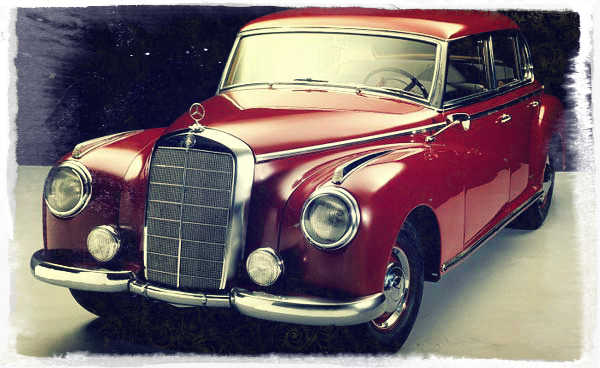
1951 Mercedes-Benz Type 300 Limo
The automobile industry in the United States established in 1950 a new all-time production record for the second successive year. Total 1950 production was 7,987,000 vehicles.
The most serious event of the year for car salesmen was the reimposition of Regulation W, the government’s credit control bill which had limited purchases during and immediately after World War II. A mild form of this control, requiring a one-third down payment with the balance to be paid within 21 months (three months longer than the wartime version) was restored in September.
Two manufacturers introduced new “small” cars during 1950, to meet the demand for (1) an economical second car for middle income families and (2) a car whose initial price placed it within reach of many people who previously had to buy used cars. Just how strong the demand was in each of these cases had yet to be established.
In design, the outstanding feature of the 1951 model year was the popularity and extension of the “hardtop convertible” introduced in 1950 models. Not convertible in the true sense of the word, these cars embodied the racy lines of a convertible while retaining a fixed steel top. This body style was extended to include four-door sedans in 1951 models. About half of the 1951 models offered hardtop styling.
In other respects the 1951 designing differed only slightly from that of 1950, since most manufacturers had provided new designing for their 1950 models. The majority of the 1951 changes were cosmetic.
There was a spectacular increase in the number of automatic transmissions offered and sold during 1950. It was estimated that well over 1.5 million fully automatic units were produced during the year.
Cars in 1952
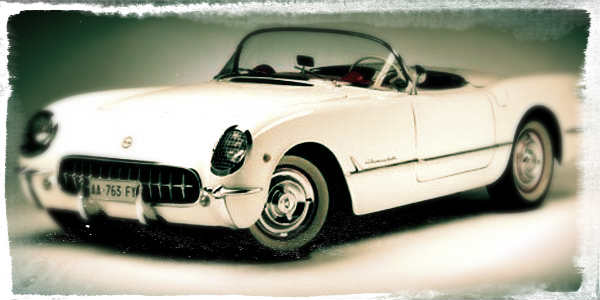
Many factors hindered production in the motor industry during 1952, the longest stoppage being caused by the nation-wide steel strike in June and July.
The job of stepping up defense production while maintaining a profitable level of civilian output was continued in 1952.
Several companies devoted as much as 60% of their work to defense, turning out, in addition to aircraft and parts, tanks and tank cannon, tactical trucks, shells and many other military items.
Shortage of materials was the greatest production problem of the industry. Copper and steel headed the list of scarce materials, with aluminium running a close second.
It was announced that air-conditioners would be available as optional equipment on at least three 1953 cars. Power steering, found on only one 1951 automobile, had its use extended to five 1952 cars. Brought out in 1951, power braking was available on two models in 1952.
Prices on new cars climbed in 1952, but taxes rose even higher. By mid-year, it was estimated that of $2,000 paid for a new automobile, $650, or about a third, went into taxes.
The possibilities of mass producing an American sports car were investigated by two manufacturers, the Packard Motor Car company and Buick Motor Division. Both companies showed their versions. While immediate production was not scheduled for either model, the producers exhibited the sports cars to test public reaction and to determine the possible extent of the market for such an automobile.
Chevy also made a concept sports car that later had some success. They called this new car a Corvette. Many people weren’t sure if they would even make a 1954 model.
Cars in 1953
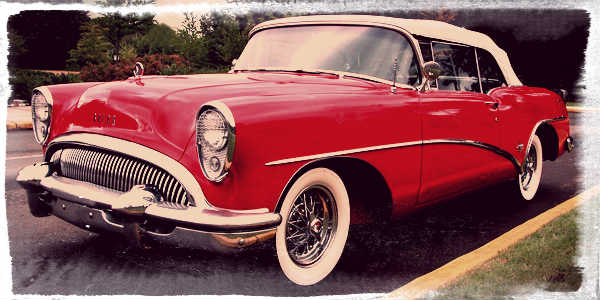
1954 Buick Skylark
After two years of shortages and restriction, the U.S. automobile industry enjoyed in 1953 what promised to be one of its best years.
One of the main factors in this production upswing was the government’s relaxation of controls on steel, copper and aluminum. The only major hindrance to production was a $70 million fire at GM’s Hydramatic plant in Livonia, Michigan.
Materials shortages, although getting much better in 1953, had inspired new ways to make car bodies. Two different cars were introduced in 1953: one with a magnesium body and the other was plastic-fiberglass.
Prices saw very little change in the 1954 models from last year’s models. And while no radical departures in styling were seen, some significant changes were made.
For example, wire racing wheels, recently only found on sports cars, enjoyed considerable popularity in the big car market. The wrap-around back window was extended to more models and the same type front windshield was introduced on the 1954 Oldsmobile Ninety-Eight Starfire, which was named after the Lockheed F9413 Starfire Fighter Jet.
The ever-swelling rural and suburban population was held responsible for the increasing popularity of the station wagon. The it had been around for over 30 years, the production volume of station wagons never rose above 1% of total production before WWII. Staying consistent with post-war utilitarian attitude, the station wagons were build with strong steel bodies and a minimum of luxury frills.
Research and engineering teams bent their efforts toward making the 1954 models safer, less expensive and easier to drive. Many lower-priced cars were being fitted with power steering. GM also introduced a new invention called the “Autotronic-Eye” which would automatically dim the high beams when a car would approach and then turn them back up when the oncoming car passed. (See ad to the right)
The postwar years watched the automatic transmission become increasingly more accepted. In 1953, more than 50% of all new U.S. models were equipped with some form of automatic shift.
Cars in 1957
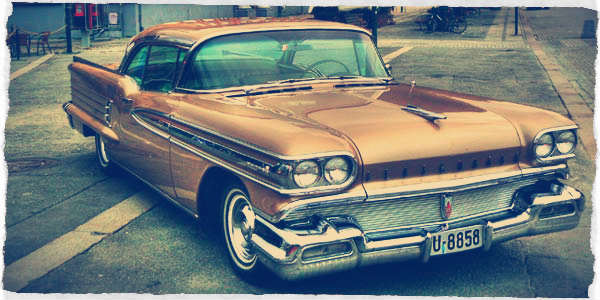
One of the most noteworthy trends in 1957 was the rise of the station wagon. Before the war, this body style was regarded as a luxury suitable only a country-estate, a resort or an occasional business establishment. By 1957, however, it had arrived as a truly popular and useful family car and accounted for more than 14% of new car sales.
Automatic transmissions, power brakes, power steering, power adjusted front seats, power window lifts and air conditioning increased in popularity. Over 80% of 1958 models had automatic transmissions.
It was at this time, car manufacturers agreed not to advertise horsepower — as it had very little connection with actual top speed. Obviously that changed.
For the first time, the US imported more cars than it exported. Volkswagen was the most popular foreign car company.
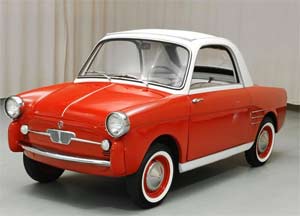
The 1958 Bianchina Supermini clocked in at 40mpg!
At this time the automobile industry dreamed of a time when a one-car family would be insufficient and people would buy different cars for different uses for different family members.
Chevrolet made striking changes to rear-end styling in their 1958 models. Ford offered a full line of luxury model Continentals as well as the medium-priced Edsel. The 1958 Oldsmobile had a completely redesigned body.
Italian car-maker Autobianchi made a supermini called Bianchina that got 40 miles per gallon. The car was presented to the public on September 16, 1957 at the Museum of Science and Technology in Milan.







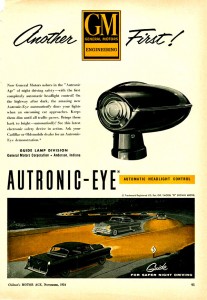




























































































































































I CAN REMEMBR THE 50 MODEL FAMILY CAR OF THE DODGE ERA / THE CORNET- THE MEDOWBROOK AND THE WHAT? THE THIRD ONE I THINK WAS A COOPE STYLE CAR I THINK? WHAT WAS IT CALLED?
greased lightning
i like seeing how the cars have changed.
@ david s hovda The Dodge Wayfarer?
Cool story bro these are great facts that will help me in my assignment
Very good source, this will help for my Humanities II Class!
These cool, interesting, and totally helpful facts are great for helping me for a power point project in class. I was actually given a standing obation
I really enjoy this website. I know so much about vehicles, and this website was a fun and exciting read. I have three 1950’s vehicles, and have restored them all myself. Very fun website. I remodeled one of my 1950’s corvettes to be a light pink, it’s beautiful. Thank you for this website. Great read.
thanks
annann
Thanks Annie!
I own a 1957 dodge royal 2dr hard top with 325 v 8 bought from original owner. It run perfect drives to easy steering very touchy I am big and I am swallowed up. It has factory air in truck huge but floats down the road. The truck has enough room to put mattres. I love driving because every one sees 57 chev and fords but not many of these.
I went to grade school on Hwy 3 in Canada. It was the main route from Detroit/Windsor to Buffalo, N.Y.
I remember that every year when the new cars came out in September, I could get an early look at the
styling changes. That was in the late 1950’s when new cars came out in September and they body styles
changed every year. Nothing like today, all cars look alike and the new models are released earlier.
At the car carrier 18 wheelers would go past the school, if they weren’t covered I could see the new body
changes. That spurred my interest in cars. I have been a car guy ever since. I swapped the engine in my
first car a ’56 Monarch (Mercury in the U.S.) 2 door hard top. Over the years I have owned some iconic
cars and restored a few. I’m now 70, belong to 2 classic car clubs and have a modified 1996 Chevy Astro mini-van. It’s something different and get lots of attention at shows. People are always asking about it in
store parking lot’s, etc. That and getting a thumbs-up from somebody, makes it all worth while.
u forgot the Lamborghini Muria
bro we got the same name dude, thats coolio dadio
My father purchased a 1957 Plymouth Suburban station wagon that was the talk of the neighborhood. It had three bench seats, and the third seat faced backward. An electric window descended into the tailgate. Then the tailgate was manually opened to access the seat (hinges were on the bottom of the door so it was pulled down). Even though this was a station wagon, the car still had fins. I still remember how big the taillights were. In 1960 we moved from Ohio to Arizona with 5 of us in the car towing a U Haul. What a great car!!
back in the 1950s the guys with nice cars picked up the pretty girls convertibles were always in because you could be seen.
In the 50’s and 60’s, power brakes were rare. The typical car had 4 drum brakes, and went without the power booster. As the cars got bigger and heavier, they were also really hard to stop. On the bigger cars, it was common to have to use both feet on the brake pedal if you wanted to stop more quickly. An extreme effort at the brake pedal would get a 50’s car stopped, still leaving plenty of time for earnest prayer while stopping the car. Rather than so much effort on the pedal, what you’d do is just use the brake pedal sooner (take twice the distance to stop).
Even with the 1969 Impala, power brakes were an option (not the standard).
There wasn’t much of a hazard evident until power brakes were standard in the 70’s; so, if you were driving a 50’s~60’s car and a 70’s car owner stopped in front of you (with their power disc brakes), in half the distance that your car required (with your manual drum brakes), a crash resulted.
does anyone remember the Hudson Hornet that was a real tank had one for two years
Bro, best car ever
The first modern disk brakes were available on the 1963 Studebaker line, along with Paxton superchargers.
I’m sure Jaguar had disc brakes in 1952/
Man, I’m a total gear head and have been as far back as I can remember, so I remember a lot. As a kid, not even 10 years old, I figured out US manufacturers would put the model year on the rear tail lights. Along with the part number of the tail light, and some other numbers you could find a two digit date on the lense. I remember pointing it out to a lot of adults, guys that worked on cars would be so surprised by it, and they loved it. If the question was “what year is that Lincoln, or any other car, I would cruise around to the tail lights and answer the question.
Thinking about tail lights, remember in the 50’s how so many cars had their gas caps hidden behind a tail light or rear license plate? I remember thinking about the engineering that went into that little feature, not to mention the manufacturing cost.
It was so helpful because I have to do a paper on all the flims and cars and other things in the 1950s. When I saw the links below for cars, fashion, etc… I was extastic because I also had to write those as well. Thanks again for making such an awesome website. I would defintiely recommmend it any of my friends and I told my teacher about this website and he told me that he is now going to be using this website as a guide to what he wants in our paper.
Bailey
My uncle bought me a 1957 pontiac 2 door hardtop. So much for high school, I pretty much lived in my car, cruising with that amazing fifties music,runaway, four seasons, etc. Thought that 283 v8 was hot. Had 8 speeding tickets on my learners licence. Mom paid my $35 fines. Those were the days. Always dreaming of a Chevy 409. My girlfriend once asked me what I would choose between her and a 409. I thought carefully and told the truth, a 409. Then while she pounded on me I said because with a 409 I could always get her. That didn’t work. I did get a 327 in a 1963 impala ss and still had her.
I remember how smooth the Chyclers cars road with the torch suspecion systems.
How many manual trans. on a 1957 Plymouth fury were built?
My dad had a Borgward Isabella, and after that a Borgward coupe for the six kids that he fathered. It were nice cars. Of course at the time I was small, only 4 or 5 years, now I’m sixty years old.
Excuse me seven kids
It was at the beginning of the sixties. And Europe started making sportscars too.
Borgward was one of the first I think.
There’s not so much known about Borgward. And it didnt last long.
We had a 1955 Chevy convertible!
Yellow and white!!!
We thought we were Hot Stuff! As teens!
i owned many cars from the 50s and 60s the 1955 Buick Skylark Convertible you show is a 1953 there never was a 1955 skylark the 1958 Pontiac you have the taillights are from a 1959 caddy i was a teenager in the late 1950 i saw all of these cars new on the show room floor and yes had a 409 chevy and first brand new car was a 1967 corvette paid $4,200 for it brand new also had a 1956 chevy convertible auto no power steering but did have power breaks with shoe and drums why people do not do more research before printing false info ill never understand